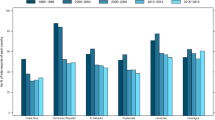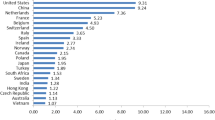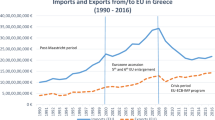Abstract
The European Union is the biggest trading bloc in the world. It is the second-largest exporter and third-largest importer of goods. However, many challenges, such as the financial crisis, the migrant crisis, BREXIT, and the COVID-19 crisis, influence negatively the prospect of increased trade liberalization among countries. The member states are imposing restraints on internal trade flows, thus jeopardizing the positive effects of trade liberalization. This paper gives a detailed overview of the trade profile of the European Union and explores the determinants of EU trade. We apply the gravity model to estimate the aggregate benefits of intra-trade or benefits from free trade agreements with third countries. We measure the influence of GDP, population, land and capital endowment, EU membership, and signed free trade agreements with the trading partners on EU trade as a dependent variable. The analysis includes data for the 82 biggest EU trading partners (including members) over a period of 60 years (from 1960 to 2020). The European Economic Community was created in 1957, but the elimination of customs duties and measures that have an equivalent effect was achieved in 1968 with the creation of the Customs Union. Due to different stages in regional integration, in particular the creation of the internal market, we estimate subsequent equations with different time periods. The main research question of this paper is: can the internal market still be the driving force for economic growth, or is widening trade relations with third countries much more important for sustaining the dominant trading position of the EU? The results show that the EU’s trade is directly proportional to the trade partner’s GDP and population. Regarding the coefficient of EU membership, it does not significantly change its value as we shorten the time periods, proving that the average trade advantage due to EU membership increases over time. On the contrary, as we shortened the time periods in the analysis, we obtained a positive but decreasing coefficient for the variable free trade agreements. This confirms that trade exchange within the EU has had a more significant effect than extra-EU trade, especially since the creation of the Internal Market.
Access this chapter
Tax calculation will be finalised at checkout
Purchases are for personal use only
Similar content being viewed by others
References
Cini, M., Perez-Solorzano Borragan, N.: European Union Politics. Oxford University Press, Oxford (2022)
Howarth, D., Sadeh, T.: The ever incomplete single market: differentiation and the evolving frontier of integration. J. Eur. Publ. Policy 17(7), 922–935 (2010). https://doi.org/10.1080/13501763.2010.499220
Camisão, I., Guimarães, M.H.: The commission, the single market and the crisis: the limits of purposeful opportunism. J. Common Mark. Stud. 55(2), 223–239 (2017)
Egan, M.: The internal market of the European Union: from indivisibility to differentiated integration. In: Laursen, F. (ed.) The Oxford Encyclopaedia of European Union Politics. Oxford University Press, Oxford (2020)
Ambroziak, A.A.: Does the European single market exist in the era of a coronavirus pandemic? The case of intra and extra-EU trade in COVID-19-related products. Studia Europejskie-Stud. Eur. Aff. 25(1), 63–83 (2021)
Baldwin, R.E., Wyplosz, C.: The Economics of European Integration. McGraw-Hill Education, London (2019)
Toshevska-Trpchevska, K.: Multilateral Trading System. University Ss. Cyril and Methodius in Skopje, Faculty of Economics-Skopje (2022)
Jovanovik, M.: The Economics of International Integration. Edward Elgar, London (2013)
Baldwin, R.E., Wyplosz, C.: Economics of European Integration. McGraw-Hill Companies, Washington (2020)
World Trade Organization: International Trade Statistics 2021. WTO, Geneva (2022). Accessed 1 April 2023
Eurostat: International trade in goods for the EU - an overview (2022). Retrieved from: https://ec.europa.eu/eurostat/statistics-explained/index.php?title=International_trade_in_goods_for_the_EU_-_an_overview&oldid=454291#International_trade_in_goods_-_intra-EU_and_extra-EU_flows. Accessed 2 April 2023
Eurostat: International trade in services (2023). Retrieved from: https://ec.europa.eu/eurostat/statisticsexplained/index.php?title=International_trade_in_services#General_overview. Accessed 2 April 2023
Eurostat: Intra-EU trade in goods-main features (2023). https://ec.europa.eu/eurostat/statisticsexplained/index.php?title=Intra-EU_trade_in_goods_-_main_features. Accessed 2 April 2023
Garrett, G.: International cooperation and institutional choice: The European Community’s internal market. Int. Organ. 46(2), 533–560 (1992). https://doi.org/10.1017/S0020818300027806
in‘t Veld, J.: Quantifying the Economic Effects of the Single Market in a Structural Macromodel. European Commission (2019)
Badinger, H.: Growth effects of economic integration: evidence from the EU member states. Rev. World Econ./Weltwirtschaftliches Archiv 141(1), 50–78 (2005). http://www.jstor.org/stable/40441034
Campos, N.F., Coricelli, F., Moretti, L.: Economic Growth and Political Integration: Estimating the Benefits from Membership in the European Union Using the Synthetic Counterfactuals Method. IZA Discussion Paper No. 8162 (2014). Available at SSRN: https://ssrn.com/abstract=2432446 or https://doi.org/10.2139/ssrn.2432446
Lehtimäki, J., Sondermann, D.: Baldwin versus Cecchini revisited: the growth impact of the European single market. Empir. Econ. (2021). https://doi.org/10.1007/s00181-021-02161-w
Thissen, M., Oort, F., Diodato, D.: Integration and Convergence in Regional Europe: European Regional Trade Flows from 2000 to 2010, ERSA Conference Papers, European Regional Science Association (2013). https://EconPapers.repec.org/RePEc:wiw:wiwrsa:ersa13p1116
Dijkstra, M.: Economies of Scale and Scope in the European Banking Sector 2002–2011. Amsterdam Law School Research Paper No. 2013-44, Amsterdam Center for Law & Economics Working Paper No. 2013-11 (2013). Available at SSRN: https://ssrn.com/abstract=2311267 or https://doi.org/10.2139/ssrn.2311267
Bogdanova, O., Orlovska, A.: Competitiveness of Nations in Global Economy Competitive Perspectives of the European Union. Econ. Manag. 446–452 (2008)
Davis, D., Gift, T.: The positive effects of the Schengen Agreement on European trade. World Econ. 37(11), 1541–1557 (2014). https://doi.org/10.1111/twec.12158
Lejour, A.M., De Mooij, R., Nahuis, R.: EU Enlargement: Economic Implications for Countries and Industries (2001). Available at SSRN: https://ssrn.com/abstract=287847 or https://doi.org/10.2139/ssrn.287847
Baldwin, R.E., Francois, J.F., Portes, R.: The costs and benefits of eastern enlargement: the impact on the EU and central Europe. Econ. Policy 12(24), 125–176 (1997). https://doi.org/10.1111/1468-0327.00018
Aturupane, C., Djankov, S., Hoekman, B.: Determinants of Intra-Industry Trade Between East and West Europe, No. 1721, CEPR Discussion Papers, C.E.P.R. Discussion Papers (1997)
Clark, D.P., Stanley, D.L.: Determinants of intra-industry trade between develo** countries and the United States. J. Econ. Dev. 24(2), 79–94 (1999)
Bergstrand, J.H.: The gravity equation in international trade: some microeconomic foundations and empirical evidence. Rev. Econ. Stat. 67(3), 474–481 (1985). https://doi.org/10.2307/1925976
Anderson, J.E., Wincoop, E.V.: Gravity with gravitas: a solution to the border puzzle. Am. Econ. Rev. 93(1), 170–192 (2003)
Anderson, J.E.: The gravity model. Annu. Rev. Econ. 3, 133–160 (2011)
Head, K., Mayer, T.: The United States of Europe: a gravity model evaluation of the four freedoms. J. Econ. Perspect. 35(2), 23–48 (2021)
Cai, M.: A calibrated gravity model of interregional trade. Spat. Econ. Anal. 18(3), 89–107 (2022). https://doi.org/10.1080/17421772.2022.2081715
Freeman, D., Meijerink, G., Teulings, R.: Trade Benefits of the EU and the Internal Market. CPB Communication (2022)
Kox, K., Lejour, A., Montizaan, R.: The Free Movement of Services Within the EU. CPB Netherlands Bureau for Economic Policy Analysis (2004)
Leitner, S.M. et al.: The Evolving Composition of Intra-EU Trade. wiiw Research Report, No. 414, The Vienna Institute for International Economic Studies (wiiw), Vienna (2016)
Nitsch, V.: National borders and international trade: evidence from the European Union. Can. J. Econ./Revue canadienne d’économique 33(4), 1091–1105 (2000)
Spornberger, J.: EU integration and structural gravity: a comprehensive quantification of the border effect on trade. Rev. Int. Econ. 30(1), 1–24 (2021)
Zaninović, V.: The intra-industry trade dynamics in CEE countries July 2022. Zbornik Radova Ekonomskog Fakulteta u Rijeci/Proc. Rijeka School Econ. 40(1), 129–145 (2022)
Bojnec, Š, Fertő, I., Fogarasi, J.: Quality of institutions and the BRIC countries’ agro-food exports. China Agric. Econ. Rev. 6(3), 379–394 (2014)
Chen, N.: Intra-national versus international trade in the European Union: why do national borders matter? J. Int. Econ. 63(1), 93–118 (2004)
McCarthy, C.: Regional Integration: Part of the Solution or Part of the Problem? Page, S., Bilal, S. (2001). Regional Integration in Western Africa. Report Prepared for and Financed by the Ministry of Foreign Affairs, the Netherlands, ODI, London (1996)
Huyên, T.K.: Trade relationship of Vietnam from the perspective of the China-US trade War 2019: a comparison study using the Gravity Model. Int. J. Manag. Innov. Entrepreneurial Res. 9(1), 01–13 (2009)
Gul, N., Yasin, H.M.: The trade potential of Pakistan: an application of gravity model. Lahore J. Econ. 16(1), 23–62 (2011)
Nguyen, K.: Gravity model by panel data approach: an empirical application with implications for the ASEAN free trade area. ASEAN Econ. Bull. 26(3), 266–277 (2009)
Lawrence, R., Weinstein, D.: Trade and Growth: Import-Led or Export-Led? Evidence From Japan and Korea. NBER Working Papers 7264, National Bureau of Economic Research, Inc. (1999)
Tinbergen, J.: Sha** the World Economy; Suggestions for an International Economic Policy. Twentieth Century Fund, New York (1962). http://hdl.handle.net/1765/16826. Accessed 16 April 2023
Helpman, E., Melitz, M., Rubinstein, Y.: Estimating trade flows: trading partners and trading volumes. Q. J. Econ. 123(2), 441–487 (2008)
Almog, A., Bird, R., Garlaschelli, D.: Enhanced gravity model of trade: reconciling macroeconomic and network models. Front. Phys. 7, 55 (2019)
Rose, A.: One money, one market: estimating the effect of currency unions on trade. Econ. Policy 15, 7–46 (2000)
Feenstra, R.C., Markusen, J.R., Rose, A.K.: Using the gravity model equation to differentiate among alternative theories of trade. Can. J. Econ. 34, 430–447 (2001)
Soloaga, I., Winters, L.A.: Regionalism in the nineties: what effect on trade? North Am. J. Econ. Finance 12, 1–29 (2001)
Yamarik, S., Ghosh, S.: A sensitivity analysis of the gravity model. Int. Trade J. 19(1), 83–126 (2005). https://doi.org/10.1080/08853900590905784
Frankel, J.A.: Is Japan creating a yen bloc in East Asia and the Pacific? NBER Working Papers, Series (4050) (1992)
Rahman, M.M., Dutta, D.: A panel data analysis of Bangladesh’s trade: the gravity model approach. J. Asia-Pac. Bus. 13, 263–286 (2003)
MinKyoung, K., Cho, G.D., Koo, W.W.: Determining Bilateral Trade Patterns Using a Dynamic Gravity Equation. Agribusiness & Applied Economics Report, No. 525 (2003)
Sandberg, H.M., Seale, J.J.L., Taylor, T.G.: History, regionalism and CARICOM trade: gravity model analysis. J. Dev. Stud. 5(42), 795–811 (2006)
Nguyen, B.X.: The determinants of Vietnamese export flows: static and dynamic panel gravity approach. Int. J. Econ. Financ. 2(4), 122–129 (2010)
Bayoumi, T., Eichengreen, B.: Ever closer to heaven? An optimum-currency-area index for European countries. Eur. Econ. Rev. 41(3–5), 761–770 (1997)
Evenett, S.J., Hutchinson, W.K.: The gravity equation in international economics: theory and evidence. Scott. J. Polit. Econ. 49(5), 489–490 (2003)
Bergstrand, J.H.: The Heckscher-Ohlin-Samuelson model, the Linder hypothesis, and the determinants of bilateral intra-industry trade. Econ. J. 100, 1216–1229 (1990)
Linder, S.B.: An Essay on Trade and Transformation. Wiley, New York (1961)
Gunnella, V., Lebastard, L., Lopez-Garcia, P., Serafini, R., Mattioli, A.Z.: The Impact of the Euro on Trade: Two Decades into Monetary Union. ECB Occasional Paper (2021/283) (2021)
Author information
Authors and Affiliations
Corresponding author
Editor information
Editors and Affiliations
Rights and permissions
Copyright information
© 2024 The Author(s), under exclusive license to Springer Nature Switzerland AG
About this chapter
Cite this chapter
Disoska, E.M., Kocevska, K.S. (2024). The Determinants of EU Trade: Evidence from Panel Data Gravity Model. In: Pellat, G., Zafiroski, J., Šuplata, M. (eds) Cooperation and Enlargement: Two Challenges to be Addressed in the European Projects—2022. Studies in Systems, Decision and Control, vol 500. Springer, Cham. https://doi.org/10.1007/978-3-031-42253-9_5
Download citation
DOI: https://doi.org/10.1007/978-3-031-42253-9_5
Published:
Publisher Name: Springer, Cham
Print ISBN: 978-3-031-42252-2
Online ISBN: 978-3-031-42253-9
eBook Packages: EngineeringEngineering (R0)




